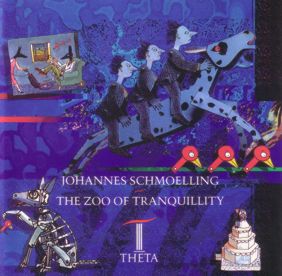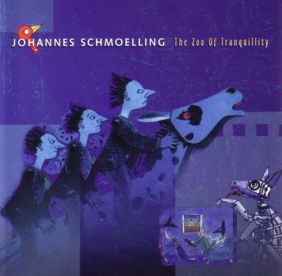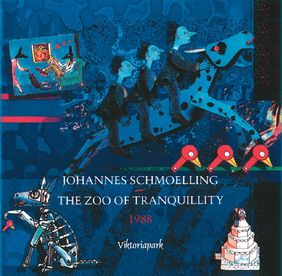 |  | |||||||||||||||||||||
Johannes Schmoelling The Zoo Of Tranquillity- Studio, released May 1988 - | ||||||||||||||||||||||||||||||||||||||||||||||||||||||||||||||||||||||||||||||||||||||||||
Covers |
| |||||||||||||||||||||||||||||||||||||||||||||||||||||||||||||||||||||||||||||||||||||||||
Tracks |
| |||||||||||||||||||||||||||||||||||||||||||||||||||||||||||||||||||||||||||||||||||||||||
Details |
| |||||||||||||||||||||||||||||||||||||||||||||||||||||||||||||||||||||||||||||||||||||||||
Notes | "This record was inspired by Paul Spooner's Illustrated Book Of Automata 'Spooner's Moving Animals' or 'The Zoo Of Tranquillity', produced by Bellew Publishing Co. Ltd. 1986, published by Virgin Books. Everyone who buys a copy of the book should go and see the Cabaret Mechanical Theatre, Covent Garden, London." | |||||||||||||||||||||||||||||||||||||||||||||||||||||||||||||||||||||||||||||||||||||||||
The Zoo Of Tranquillity, Johannes Schmoelling's second album was released in 1988 and can be characterised as concept album: most track titles directly refer to automata created by British artist Paul Spooner. | ||||||||||||||||||||||||||||||||||||||||||||||||||||||||||||||||||||||||||||||||||||||||||
The booklets of the Tangerine Dream "Definitive Edition" CDs, released by Virgin in 1995, featured an essay by journalist Mark Prendergast saying: "Schmoelling's interest in a sleek commercial sound and the quirkiness of automata is apparent on White Eagle, Logos Live and Hyperborea." This statement is even more true for The Zoo Of Tranquillity, as Johannes Schmoelling succeeds in creating rhythms and sounds that make those automata almost appear before the listener's eyes. | ||||||||||||||||||||||||||||||||||||||||||||||||||||||||||||||||||||||||||||||||||||||||||
In an interview with Paul Lawler from 2006 Johannes Schmoelling remembers: "I started to work on this album in October 1987, after I had built my new recording studio after four months construction work. And Polygram -- Theta label -- longed for the record in the end of January 1988. So I had only three months for producing. In my case a very short period, because I like to have plenty of time for the process of composing etc. And with the birth of my son Jonas in September 1987 I found the book 'Moving Animals or The Zoo of Tranquillity' from Paul Spooner in a book store. Form that moment I knew that's exactly what I was looking for. A wonderful title for an album and a source of inspiration for sound arrangements and sound sampling. At this time I liked very much to record any sounds, outside or inside, with my Sony Walkman tapemachine and a stereo mic. Afterwards I fed specific parts into my Akai Sampler and started to play with them on my master keyboard until something useful was created. Quite often these sampled sounds gave me the idea for a composition or for a specific rhythm." | ||||||||||||||||||||||||||||||||||||||||||||||||||||||||||||||||||||||||||||||||||||||||||
Re-Releases | ||||||||||||||||||||||||||||||||||||||||||||||||||||||||||||||||||||||||||||||||||||||||||
The album was released on the short-lived Dutch label Theta, hence it became very rare a few years after its release. In February 2008 the music became available as download from Johannes Schmoelling website (see Links). | ||||||||||||||||||||||||||||||||||||||||||||||||||||||||||||||||||||||||||||||||||||||||||
In 2010 Johannes Schmoelling re-released the original version of that album on CD, completely remastered from the original two-track tapes. Some of the tracks are somewhat shorter than on the original album. There are three versions of this re-release: The first one has a misprinted booklet, scheduled for release on October 15, 2010 at the 11th Ricochet Gathering in Berlin. It was never sold like that, but with a reduced booklet omitting the pages 3 to 6, making this the second version. The booklet was later reprinted in November 2010 for the third version. | ||||||||||||||||||||||||||||||||||||||||||||||||||||||||||||||||||||||||||||||||||||||||||
The 1998 Re-Recording | ||||||||||||||||||||||||||||||||||||||||||||||||||||||||||||||||||||||||||||||||||||||||||
The album was as well completely re-recorded and re-released in 1998. For this re-release, apparently all tracks had been entirely re-recorded, often changing the tone colours used, thus some of the newly arranged tracks may produce even somewhat different feelings than their original counterparts. Furthermore, the track sequence has been changed completely, and two new, previously unreleased compositions have been added. | ||||||||||||||||||||||||||||||||||||||||||||||||||||||||||||||||||||||||||||||||||||||||||
In an interview for the magazine Beyond the Horizon in 1997 Johannes Schmoelling tells about this re-release: "Polygram Records allowed [the original album] to disappear from their catalogue back in 1991. From that time on, I've received many letters about it, from people asking where they could buy a copy. So I decided that as soon as it was possible and legal, I would re-release the album. When I started working on the album again in August of last year, my first intention was to remix some tracks because of better mixing conditions in my new studio. But when I listened to the original multi-track tapes, I was surprised to find some old versions of some of the songs -- such as The Anteater -- which I liked more than the tracks which eventually made it on to the original album. That discovery led me to want to release a new edition of the album [...] almost ten years after the first release." | ||||||||||||||||||||||||||||||||||||||||||||||||||||||||||||||||||||||||||||||||||||||||||
According to the liner notes, the album "was inspired by concepts and designs of British artist Paul Spooner, who happens to be a master of sculptural animation. Spooner created an anteater, a lion and a woodpecker among others, for his book 'Moving Animals'. Johannes Schmoelling was tempted to capture the magic of little absurd machines cheerfully spinning, lazily grinding, endlessly wiggling. 'I like to create scenarios for the ears, to give a certain depth, perspective, colouring and three-dimensional quality to sound textures. I like to arrange them like stage-sets.'" | ||||||||||||||||||||||||||||||||||||||||||||||||||||||||||||||||||||||||||||||||||||||||||
Releases |
| |||||||||||||||||||||||||||||||||||||||||||||||||||||||||||||||||||||||||||||||||||||||||
Copyright/Disclaimer © 2001-2025 by Michael Berling. Last Update: 2025-01-03 17:20 |





